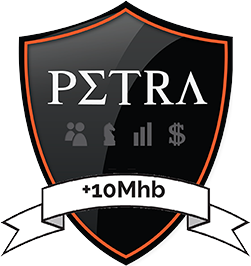Recently, Petra Coach presented a webinar, Engaged, Accountable & Performing in a Remote Environment with Robert Glazer.
You can find the full recording below.
Book – How to Thrive in the Virtual Workplace
Course – Thriving in the New World of Remote Work
- Coupon Code: petra
Top Takeaways
Introduction
You survived 2020. What comes next?
- A lot of transitions were already under way; the pandemic just advanced it 5-7 years
- The best decision you can make for your organization/team is looking forward, not backward
- Supply and demand are undefeated
Are companies willing to lose top talent by forcing people to return to the office full time, when they’ve shown the work can get done without that?
In a survey of 2,000 employees who worked remotely in 2020, 68% want to continue working remotely either most of all of the time, while 2% want to return to full-time, in-person work.
What Do Remote Employees Need?
Good Set Up
- The Right Equipment
- Good internet
- Sit/stand desk
- Extra screen
- Ring light
- External microphone
Good Tactics for Their Workday
- Clearly Defined Boundaries
- Dedicated Workspace
- Not taking your laptop to breakfast and bed
- Let other people in your home know you are unavailable in that space
- Structured Schedule
- The more routine, the better
- Sync your schedule with people working on the same projects as you
- Energy Management
- Warm up, Grind, Easy Work, Break
- Inbox Management
- Designate certain times of day to reply to emails
Some Way to Have Positive Work/Life Integration to Avoid Burnout
- Don’t start work right away in the morning, and don’t do it until last thing at night
- Have your proactive morning routine before you bring work into your home
- Recreate the commute
- Important decompression time
- What is your signal? Give yourself 30 minutes to walk to meditate. Change into your home clothes.
- Make time for self care
What Do Leaders Need to Do?
- Hire the Right People
- Who by Geoff Smart
- Create a repeatable hiring roadmap
- Have Comprehensive Onboarding and Training
- What starts well tends to go better
- Eliminate Unnecessary Meetings
- When you move to remote work, you need to reevaluate the purpose and productivity of your meetings
- Cut the rest in half
- 60 minutes on Zoom is a lot more difficult than 60 minutes in person
- Eliminate Update Meeting
- Meetings should be interactive, not one person talking
- Leverage Asynchronous Video
- “Hear from Me” videos – info shared from CEO
- Manage Outcomes, Not Inputs
- What are people actually getting done? Who is most efficient? Set the benchmark from there.
- Delegate More
- You need to be able to communicate and trust your employees
- Set KPIs and outcomes
- 85% Rule
- Delegation is a success when it’s done 85% the way you would’ve gotten it done
- Trust, but Verify
- No spy tech, but make sure the work is getting done
- Availability and Accountability
- If you’re taking a coffee break, you don’t need to tell anyone
- If you’re going to be out of touch for a few hours, you need to keep people in the loop
What Do Organizations Need to Do?
Create and Publish a Go-Forward Strategy
- A lot of employees are unsure what their company’s plan even is
- One approach is the “no flexibility” approach
- Some are going fully remote
- We will see the most hybrid workplaces
Hybrid Workplaces
- “Work from anywhere” is a terrible idea
- Employment laws, taxes, benefits, etc. vary by state and country
- It’s extremely expensive to go back and fix this
- This tends to come up when you’re selling your company
Questions to Ask When Considering a Hybrid Workplace
- How far from an “office” can people live?
- What are they expected to be in the office? Can it be short notice?
- How are meetings handled?
- How will you level the playing field for people who are out of sight?
- How will you handle blue collar/white collar divisions?
Hub Model
- One hybrid model is “hub model”
- Company has a certain number of hubs in places with good access to the demographics and client they need
- Employees can work in those select places
Fly Your Flag
- Be transparent about who you are as an employer
Key Takeaways
- We’re not going back to 2019
- The smartest companies are looking at the changes as opportunities – forward not backwards
- Companies/teams need to pick a strategy and support it 100%
- Hybrid needs to be a strategy in itself, not the absence of one
- Don’t default to it without the policies and clarity you need
Like what you see? Register for our upcoming workshops & webinars today!




